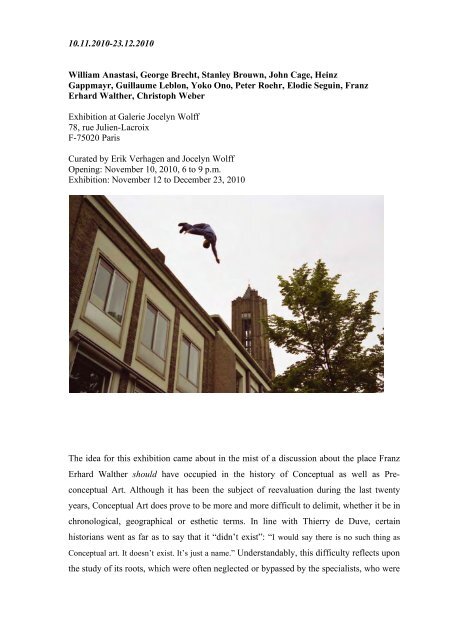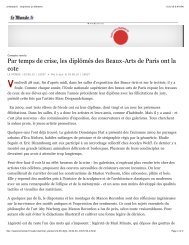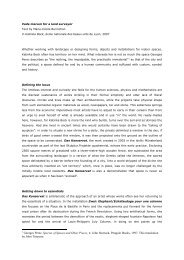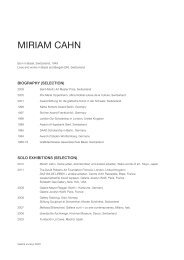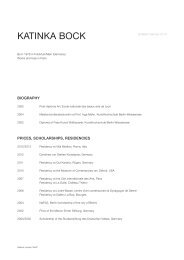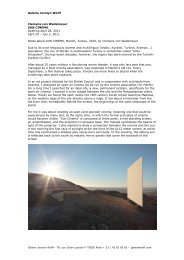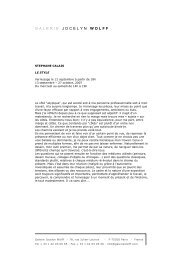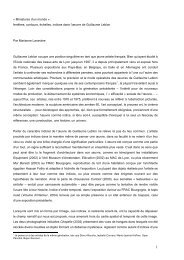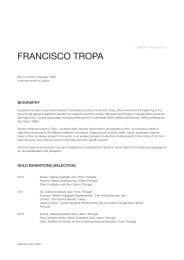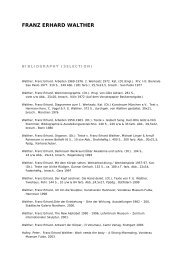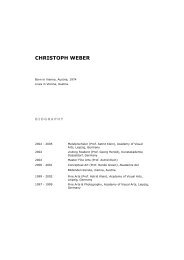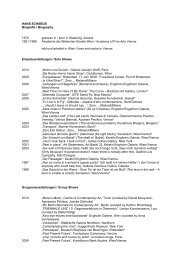English presentation - Galerie Jocelyn Wolff
English presentation - Galerie Jocelyn Wolff
English presentation - Galerie Jocelyn Wolff
You also want an ePaper? Increase the reach of your titles
YUMPU automatically turns print PDFs into web optimized ePapers that Google loves.
10.11.2010-23.12.2010<br />
William Anastasi, George Brecht, Stanley Brouwn, John Cage, Heinz<br />
Gappmayr, Guillaume Leblon, Yoko Ono, Peter Roehr, Elodie Seguin, Franz<br />
Erhard Walther, Christoph Weber<br />
Exhibition at <strong>Galerie</strong> <strong>Jocelyn</strong> <strong>Wolff</strong><br />
78, rue Julien-Lacroix<br />
F-75020 Paris<br />
Curated by Erik Verhagen and <strong>Jocelyn</strong> <strong>Wolff</strong><br />
Opening: November 10, 2010, 6 to 9 p.m.<br />
Exhibition: November 12 to December 23, 2010<br />
The idea for this exhibition came about in the mist of a discussion about the place Franz<br />
Erhard Walther should have occupied in the history of Conceptual as well as Pre-<br />
conceptual Art. Although it has been the subject of reevaluation during the last twenty<br />
years, Conceptual Art does prove to be more and more difficult to delimit, whether it be in<br />
chronological, geographical or esthetic terms. In line with Thierry de Duve, certain<br />
historians went as far as to say that it “didn’t exist”: “I would say there is no such thing as<br />
Conceptual art. It doesn’t exist. It’s just a name.” Understandably, this difficulty reflects upon<br />
the study of its roots, which were often neglected or bypassed by the specialists, who were
undoubtedly cautious of the idea of registering Conceptualism within the continuity or<br />
proximity of partially incompatible tendencies (Fluxus, Minimal Art, Concrete Poetry).<br />
Taking into consideration the official chronology that makes the conceptual movement<br />
start in 1966 with the exhibition (Working Drawings and Other Visible Things on Paper not<br />
necessarily meant to be Viewed as Art) curated by Mel Bochner at the School of Visual Arts<br />
in New York, the selected works and proposals for our exhibition date prior to this and<br />
always deal with one or some criteria that thereafter became inextricable from Conceptual<br />
Art. The importance the artists placed on processes (William Anastasi, Stanley Brouwn,<br />
Yoko Ono) and instructions (William Anastasi, Stanley Brouwn, Yoko Ono), on<br />
dematerialization (William Anastasi, George Brecht, John Cage) and tautology (William<br />
Anastasi, Peter Roehr), on questioning the author’s status (Stanley Brouwn, Yoko Ono)<br />
and on language (George Brecht, Heinz Gappmayr, Peter Roehr, Franz Erhard Walther)<br />
indisputably announce the founding principles of Conceptualism. And if it is not about<br />
claiming that they adhere completely, the inherent prodromic dimension turns out to be<br />
convincing. In an effort to remain loyal to the mindset carried by a certain few of these<br />
works and to avoid any vintage qualities that could prove undermining, we decided to opt<br />
for the standpoint that consists in adapting them to contemporary technology. It is from<br />
within this perspective and following a conversation with William Anastasi that his two<br />
essential pieces (Sink and Microphone), whose conception dates the first third of the<br />
1960s, became “updated”. The integration of propositions from young artists (Guillaume<br />
Leblon, Elodie Seguin, Christoph Weber) from the gallery, which appear as veiled<br />
references to other, major, protoconceptual figures (respectively Yves Klein, the On<br />
Kawara before the date paintings, and Robert Morris), demonstrates how the after can<br />
take a critical look at the before in a way which is as singular as it is vitalizing.<br />
Erik Verhagen<br />
Illustration: Guillaume Leblon, Temps libre, 2001, performance June 3, 2003,<br />
Sonsbeek 9, Arnhem, Pays-Bas<br />
The second volet of this exhibition begins January 8, 2011.


